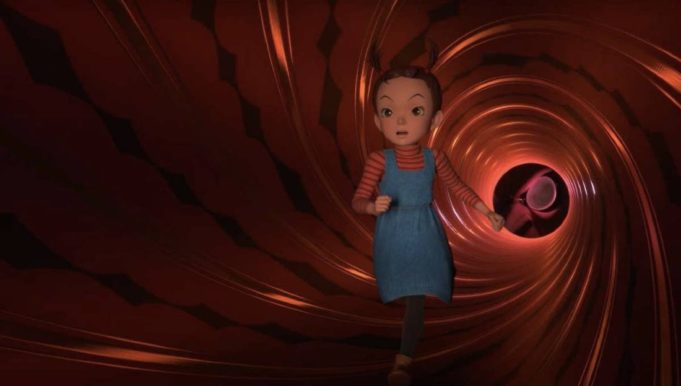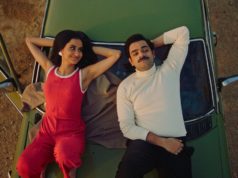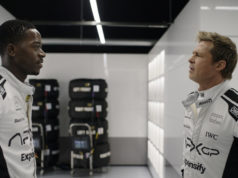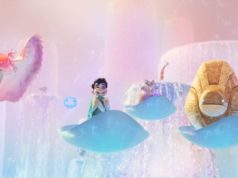The headline about Earwig and the Witch is that this is the first computer-drawn animated film made by the Japanese outfit Studio Ghibli. While the legendary Hayao Miyazaki has been an apostle of beautiful hand-drawn animation, his son Gorō has directed the studio’s move into 3D digital anime. I’m not sure that this marks the end of hand-drawn Japanese animation, as some knowledgeable folks have claimed — we still have the likes of Masaaki Yuasa and Keiichi Hara producing stunning work. I did not find that the pixels added much to the story, but I did find the film engaging enough to follow.
The film is based on a children’s book by Diana Wynne Jones, whose Howl’s Moving Castle and Castle in the Air were both adapted into Hayao Miyazaki movies. Being based on a children’s book may explain why the film struggles to fill out its 82-minute running time. The story begins in England, with a witch (voiced by Sherina Munaf in the Japanese-language version and Kacey Musgraves in the English-dubbed one) leaving a baby girl at an orphanage, whose matron is outraged that someone would name a baby Earwig. Years later, the girl (voiced by Kokoro Hirasawa and Taylor Henderson) is comfortably ensconced there, since everyone there mysteriously does whatever she wants. She’s none too happy, then, when she’s adopted by Bella Yaga (voiced by Shinobu Terajima and Vanessa Marshall), a witch who has no affection for the child and puts Earwig to work in her dingy lab. Earwig wants to learn spells, but the ones Bella Yaga has are dinky ones for things like winning dog shows. Running away isn’t an option, either, because her new home has windows that won’t open and doors that disappear. To take control of her situation, she’ll need the help of Thomas (voiced by Gaku Hamada and Dan Stevens), the put-upon black cat who acts as Bella Yaga’s familiar.
It turns out that Earwig’s inherent witchiness was the reason why people did her bidding at the orphanage, and the story revolves around her attempts to snag that kind of sway in her new home. The script never bothers to ask whether that’s necessarily the best thing for a pre-teen girl, even if it’s preferable to indentured servitude. Bella Yaga isn’t an imposing antagonist, as shown by the fact that she’s terrified of The Mandrake (voiced by Etsushi Toyokawa and Richard E. Grant), the extremely tall, pointy-eared man who lives with them and insists on no one disturbing him. The Mandrake is more formidable as a guy whose glare sets his glasses on fire when he’s angry, but the film never tells us what his deal is. The history with him, Bella Yaga, and Earwig’s mother doesn’t chime any resonant notes, either.
With all this, I still found this odd story more interesting than most Hollywood movies made for children, with Stevens fitting the role of a cat quite well and the rules of this witchcraft-ruled world shifty enough to keep you guessing. Also, we get to hear Musgraves as a character who fronts a rock band, and that’s different from what she usually does. Earwig and the Witch is wifty and lacking in the gravitas of the best anime films, but I found myself sitting still and paying attention for the duration.
Earwig and the Witch
Voices by Taylor Henderson and Dan Stevens. Directed by Gorō Miyazaki. Written by Keiko Niwa and Emi Gunji, based on Diana Wynne Jones’ book. Rated PG.












